Energy Timeline
from 1971 to 1980
1939-1950 1951-1970 1971-1980 1981-1990 1991-2000 2001 2002 2003 2004
July 4, 1971
President Nixon announces as a national goal a commitment to complete a Liquid Metal Fast Breeder Reactor demonstration plant by 1980. In what he refers to as the first comprehensive energy message to Congress by a United States president, Nixon calls the breeder reactor the best hope for meeting the growing demand for economical clean energy.
August 7, 1972
The Atomic Energy Commission announces a cooperative agreement with industry to build a Liquid Metal Fast Breeder Reactor on the Clinch River in Tennessee.
June 1973
President Nixon directs Dixy Lee Ray, Chairman of the Atomic Energy Commission, to review federal and private energy research and development activities and recommend an integrated national program.
June 29, 1973
President Nixon establishes the Energy Policy Office. The office is responsible for formulating and coordinating energy policies at the presidential level.
October 6, 1973
The Yom Kippur War breaks out in the Middle East. October 17, 1973, the Organization of Arab Petroleum Exporting Countries declares an oil embargo, sparking the first "energy crisis."
November 7, 1973
President Nixon launches Project Independence, with the goal of achieving energy self-sufficiency by 1980. Recalling the Manhattan Project, Nixon declares that American science, technology, and industry can free the United States from dependence on foreign oil.
December 4, 1973
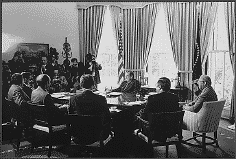 The Federal Energy Office replaces the Energy Policy Office. The new office is assigned the task of allocating reduced petroleum supplies to refiners and consumers and of controlling the price of oil and gasoline. William Simon is named Administrator. The Federal Energy Office replaces the Energy Policy Office. The new office is assigned the task of allocating reduced petroleum supplies to refiners and consumers and of controlling the price of oil and gasoline. William Simon is named Administrator.
May 7, 1974
President Nixon signs the Federal Administration Act of 1974. The Federal Energy Administration replaces the Federal Energy Office.
August 9, 1974
Gerald R. Ford becomes President.
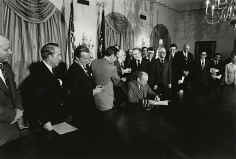 October 11, 1974 October 11, 1974
President Ford signs the Energy Reorganization Act of 1974. The Atomic Energy Commission is abolished. The Energy Research and Development Administration, Nuclear Regulatory Commission, and Energy Resources Council are established.
November 25, 1974
President Ford appoints Frank Zarb as Administrator, Federal Energy Administration.
January 19, 1975
The Energy Research and Development Administration is activated. The new agency is given responsibility for the Atomic Energy Commission's nuclear weapons program. President Ford appoints Robert C. Seamans, Jr., as Administrator.
December 22, 1975
President Ford signs the Energy Policy and Conservation Act, extending oil price controls into 1979, mandating automobile fuel economy standards, and authorizing creation of a strategic petroleum reserve.
January 20, 1977
Jimmy Carter is inaugurated President.
February 2, 1977
President Carter signs the Emergency Natural Gas Act of 1977.
February 7, 1977
John F. O'Leary is named Administrator, Federal Energy Administration.
April 18, 1977
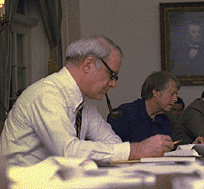 President Carter announces National Energy Plan in his first major energy speech. His plan calls for the establishment of an energy department. President Carter announces National Energy Plan in his first major energy speech. His plan calls for the establishment of an energy department.
August 4, 1977
President Carter signs the Department of Energy Organization Act. The Federal Energy Administration and Energy Research and Development Administration are abolished.
August 5, 1977
James R. Schlesinger is sworn in as first Secretary of Energy.
October 1, 1977
DOE is activated. Bringing together a score of organizational entities from a dozen departments and agencies, the new department is also given responsibility for the nuclear weapons program.
November 9, 1978
President Carter signs the National Energy Act, which includes the National Energy Conservation Policy Act, the Power Plant and Industrial Fuel Use Act, the Public Utilities Regulatory Policy Act, the Energy Tax Act, and the Natural Gas Policy Act.
January 16, 1979
Shah flees Iran. Cessation of oil exports results in worldwide shortage of oil. Oil-consuming nations are using two million barrels of oil a day more than are being produced.
March 28, 1979
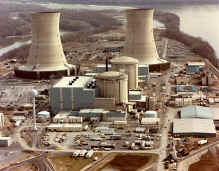 An accident occurs at the Three Mile Island nuclear power plant. An accident occurs at the Three Mile Island nuclear power plant.
April 5, 1979
President Carter, responding to growing energy shortages, announces gradual decontrol of oil prices and proposes windfall profits tax.
June 20, 1979
President Carter announces program to increase Nation's use of solar energy, including solar development bank and increased funds for solar energy research and development.
July 10, 1979
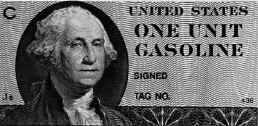 President Carter proclaims a national energy supply shortage and establishes temperature restrictions in nonresidential buildings. President Carter proclaims a national energy supply shortage and establishes temperature restrictions in nonresidential buildings.
July 15, 1979
President Carter declares energy to be the immediate test of ability to unite the Nation and proposes $88 billion decade-long effort to enhance production of synthetic fuels from coal and shale oil reserves.
August 24, 1979
Charles W. Duncan, Jr., is sworn in as second Secretary of Energy.
June 30, 1980
President Carter signs the Energy Security Act, consisting of six major acts: U.S. Synthetic Fuels Corporation Act, Biomass Energy and Alcohol Fuels Act, Renewable Energy Resources Act, Solar Energy and Energy Conservation Act and Solar Energy and Energy Conservation Bank Act, Geothermal Energy Act, and Ocean Thermal Energy Conversion Act. |